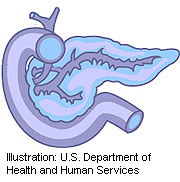Guidelines recommend surveillance for low-risk cysts, discontinuation after no change for five years
FRIDAY, March 27, 2015 (HealthDay News) — New, less aggressive guidelines have been developed for management of pancreatic cysts. The guidelines were published in the April issue of Gastroenterology.
On behalf of the American Gastroenterological Association, Santhi Swaroop Vege, M.D., from the Mayo Clinic in Rochester, Minn., and colleagues reviewed the evidence and presented recommendations on the management of asymptomatic pancreatic neoplastic cysts.
According to the guidelines, patients need to have a clear understanding of programmatic risks and benefits before starting any pancreatic surveillance program. Once this is established, the authors recommend magnetic resonance imaging (MRI) in one year and then every two years for five years if there is no change in size or characteristics of pancreatic cysts <3 cm. Endoscopic ultrasonography and fine needle aspiration (EUS-FNA) should be used to examine cysts with at least two high-risk features. Patients without concerning EUS-FNA results should undergo MRI surveillance after one year and then every two years. Significant changes in cyst characteristics are indications for EUS-FNA. If there is no change in the cyst characteristics after five years or if the patient is no longer a candidate for surgery, surveillance can be discontinued. Surgery should be conducted at centers with demonstrated expertise in pancreatic surgery. Patients with invasive cancer or dysplasia in a cyst that has been surgically resected should undergo continued MRI surveillance.
“The American Gastroenterological Association deserves congratulations for its bold recommendations,” Russell P. Harris, M.D., M.P.H., of the University of North Carolina at Chapel Hill, writes in an ideas and opinions piece published simultaneously in the Annals of Internal Medicine. “In today’s medical atmosphere, it is difficult for any group to recommend less aggressive care. Until better evidence is available, we will not know if the AGA guidelines provide greater value than previous ones, but they thoughtfully adopted a value framework. To get value from new technology, we have to learn to use it with the restraint necessary to minimize harms and costs while preserving benefit.”
Copyright © 2015 HealthDay. All rights reserved.








